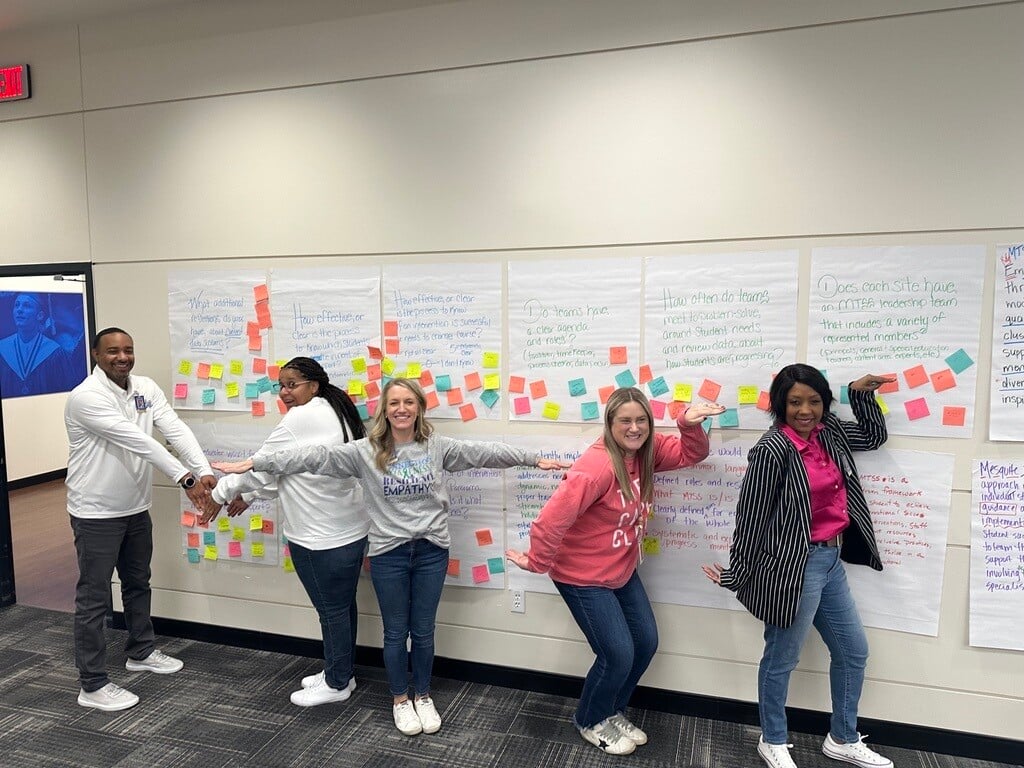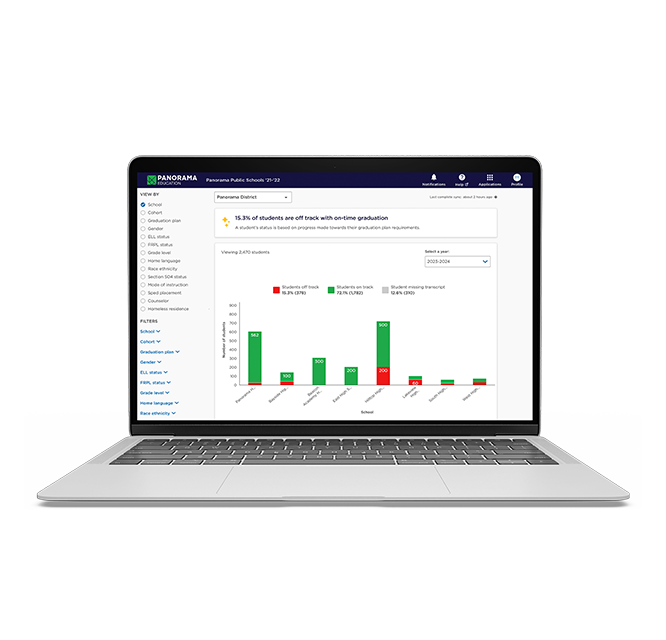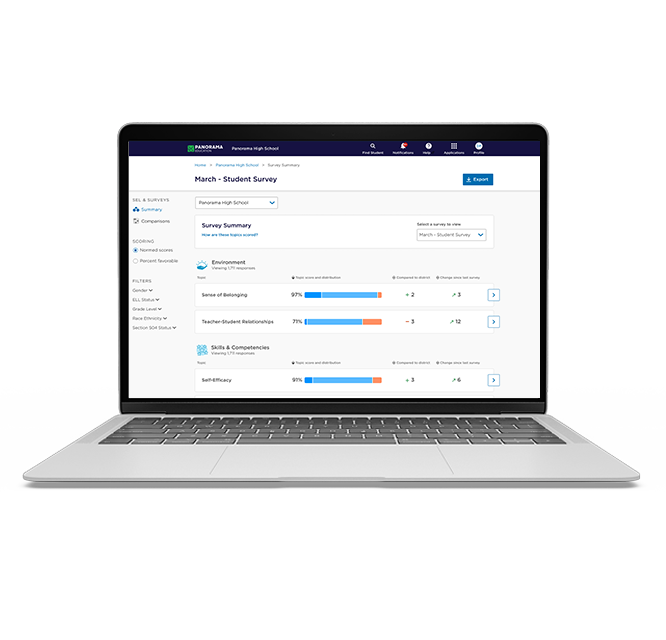Located along Lake Michigan, Racine Unified School District (WI) serves nearly 16,000 students across 21 schools. Like many districts nationwide, Racine saw absenteeism rise and knew it needed a more proactive, data-informed approach to help students stay connected to school.
To meet these challenges, district leaders turned to Panorama Student Success and AI tools to understand why students were missing school and to build stronger connections with families.
Challenges
- Racine Unified was committed to improving student attendance, but efforts were often reactive, making it difficult to identify and address the multi-layered causes of chronic absenteeism.
- Schools lacked a consistent and accurate system for pulling correct attendance data, cleaning up records, and using common language across 21 sites.
- Educators needed more ways to connect attendance data with student belonging and family engagement.
Solution
Results
- One school within the district, the Academies of Racine at Jerstad-Agerholm, closed a 13% attendance gap among student groups through data-driven practices that strengthen belonging
- Additionally, the Academies of Racine at Jerstad-Agerholm reduced chronic absenteeism by 3%, resulting in 30 more students attending regularly at one school alone.
- Schools strengthened student belonging and family engagement through proactive communication, empathy-driven outreach, and consistent celebration of success.
Challenges
After the COVID-19 pandemic, Racine Unified School District, like many districts, saw attendance challenges intensify. Leaders realized that tracking attendance after problems surfaced wasn’t enough. They needed to understand why students were missing school and how to bring them back.
“A lot of times attendance is something that takes the back burner to everything else,” said Stephanie Hullum, Attendance Coordinator at Racine Unified. “When we get time to finally work on it, we’re throwing darts and hoping it sticks somewhere—not really knowing what we’re throwing darts at.”
To make progress, Racine replaced assumptions with accurate, consistent data. Hullum and her team led a districtwide effort to review attendance practices and ensure every school was tracking data the same way.
“We gave them guidance on how to make sure everything is cleaned up in their buildings—pulling the correct attendance data, having conversations with our teachers on what a tardy is, what a truancy is,” Hullum explained.
Those steps laid the groundwork for a unified attendance framework. District leaders also provided schools the structure and support needed to prioritize attendance.
“Our district-level guidance and support has been instrumental in our push to increase student attendance,” said Jason Paproth, Directing Principal for Racine Unified. He noted that the district helped form school-based attendance teams to clarify roles and build shared routines around reviewing data.
Even with this new focus, Racine’s leaders knew that data alone wouldn’t solve the problem. Educators still needed to connect the numbers to students’ experiences and understand how belonging and relationships might hold the key to improving attendance.
Solution
With consistent systems in place, Racine partnered with Panorama Education to uncover why students were missing school and how to help them reengage. The goal was to hear directly from students and families about the challenges behind absences, from transportation barriers and family responsibilities to mental-health needs or school climate concerns. These responses have given Racine a clearer picture of what students were actually experiencing beyond the numbers.
“Panorama can be really huge for [implementing] those interventions for those kids that feel like they don’t belong at school,” said Hullum. Teams use survey data to guide interventions and connect students with staff who can help them feel supported.
Racine uses Panorama Student Success to bring attendance, academic, and belonging data together in one place. AI-powered tools (such as Insights, Signals, and the Chronic Absenteeism Dashboard) help staff identify groups of students who may need extra connection or outreach. For example, the team can quickly pull last year’s seventh graders who were chronically absent and reported low belonging, then match those students with an adult champion at the start of the school year.
Hullum added that the same technology helps teams plan more purposeful conversations. “One of the coolest features we have is the AI button where we can say ‘Show me an insight to a child’—as we're sitting as a team, we can instantly see how we can get this student more involved, more connected with school.”
On their student survey, Racine removed anonymity from the sense-of-belonging question. “That was one of the easiest data points to get, so we could assign a champion to that student [right away] and help them get connected to school.”
By combining these tools with ongoing family communication, Racine’s attendance teams are learning to anticipate barriers before they grow. The district now focuses on understanding—not just recording—why students are absent and ensuring that data leads to meaningful support.
Results
The impact is already visible across Racine’s schools. Paproth noted the impact at The Academies of Racine at Jerstad-Agerholm:
“When I was hired a little more than three years ago, our Black students were attending at a 13% lower rate than their other counterparts,” said Paproth. “At the end of last school year, we had erased that entire discrepancy, and now all of our student groups, regardless of race, are attending within two percentage points of each other. And that's through those intentional interventions like calling the families, calling the kids, and making them understand that we really do want them here.”
He added, “Last year, at my site, we reduced chronic absenteeism by 3%. Even though that doesn’t seem like a large number, we are a K–8 school with over a thousand students—so that’s 30 more off the chronic absenteeism list.”
Much of this progress came from using Panorama’s tools to uncover a key insight: that belonging was one of the strongest predictors of whether a student showed up to school. “Through using Panorama, [we now understand] that sense of belonging we find is one of the main reasons our kids are not in school,” Paproth said. “They miss one day, two days, three days, nobody calls home, nobody asks about them. They feel like it didn’t matter.”
In response, Racine launched simple, consistent ways to remind students that they matter. These included recognition for improved attendance and visible reminders like the district’s “You Belong Here” initiative.
When students feel seen and supported, they’re more likely to show up. That belief now shapes Racine’s approach to attendance. By combining data with everyday moments of care and recognition, the district is making belonging a real driver of student success.
Looking Ahead: Next Steps
Even with these improvements, Racine leaders see attendance as ongoing work, not a finished project. “Our district has seen a decline in chronic absenteeism, but I’m not gonna pretend that we don’t have a lot more growth to do,” Hullum said. “We still have some of our schools sitting at 50% chronic absenteeism. What we’re missing in our approach is that student and family voice.”
The district is exploring new ways to bring those voices forward through one-on-one conversations with students and families and surveys that explore barriers to consistent attendance.
Racine plans to keep building on this work using Panorama’s tools alongside authentic relationships to make attendance improvement a lasting effort rooted in listening, belonging, and connection across the whole school community.










![How AI Ready Is Your District? [Infographic]](https://www.panoramaed.com/hubfs/iStock-1912513615.jpg)